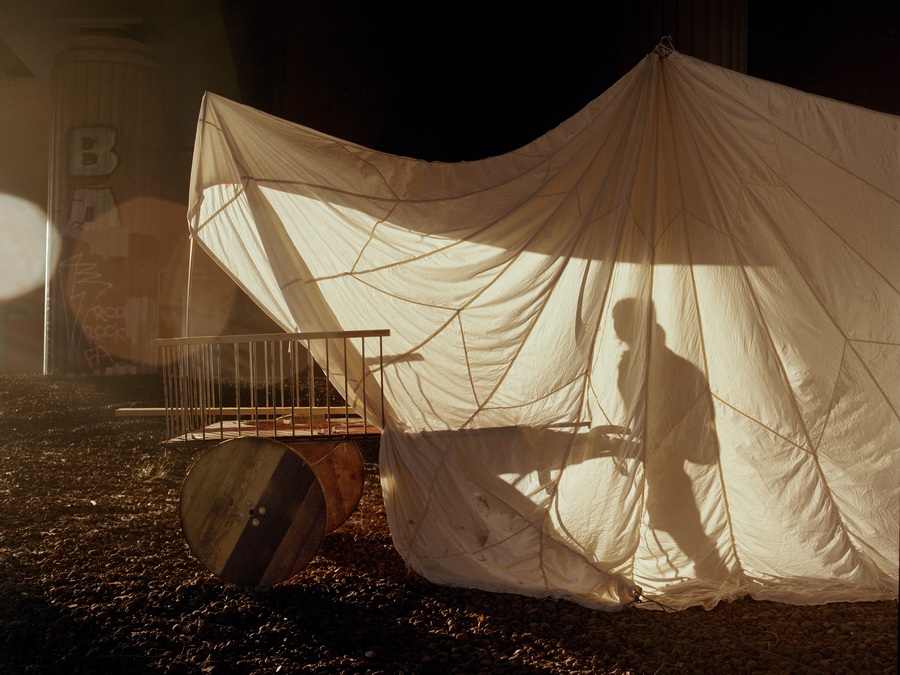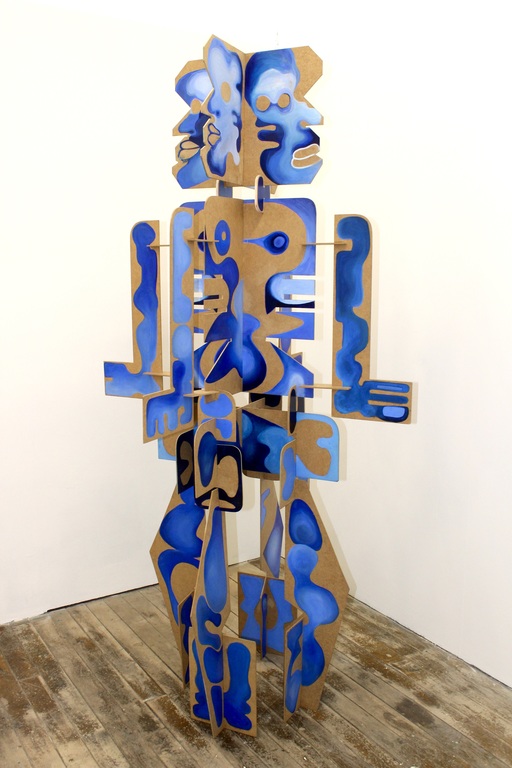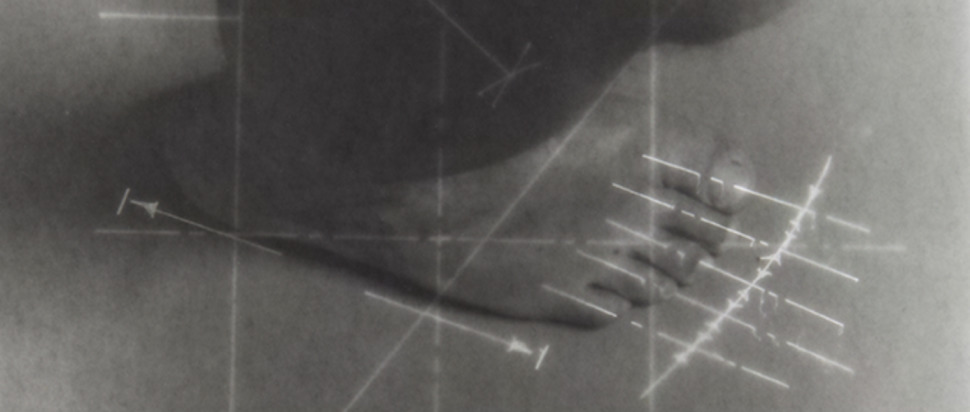GSA Degree Show 2025: Fine Art
In this year's Degree Show, students in the School of Fine Art are reaching out for connection, building worlds, and constructing narratives that question memory, place, and concepts of the self, both culturally and individually
This year’s graduating Sculpture and Environmental Art students have shown a distinct move away from minimalism. Instead, this exhibition features a wealth of personal, theatrical, and autobiographical artwork exploring myths, culture, movement, and memories.
Emilia Evans-Munton’s project Remember I’m Still Here is a 20-metre long sock monkey, designed to set the tone for the sculpture year group, and is the first thing viewers see as they approach the Stow Building. This work, like many others from the year group, is intended to create a welcoming space for people to gather and interact. In many areas, in fact, students have broken away from the conceptual elements that can distance many viewers, and moved towards creating work to be enjoyed by a wider audience through shared experience and interaction.
Inside, Harry Boulton’s immersive installation explores the process of moving home and digs into the idea that ‘shelters are not just structures but containers of identity, (and) memory’. Boulton plays with the idea of claustrophobia, utilising a vast array of moving parts and materials. Like many of the sculpture students, he seizes the final opportunity to go big.
Mimicking movement as it occurred in ancient tales, Agnes Sharp’s performance work draws on themes from The Odyssey. Sharp’s exhibition consists of a series of photos documenting her journey dragging a two-metre-long steel and wood trailer from the Stow Building to Queen's Park, carrying PA systems, light and band equipment. This performance happened alongside a choir, her friends, and many members of the public, who spent the time telling stories, singing, and moving the cart in the rain in a display of community and human connection through storytelling.
Maha Al Yousefi similarly explores these themes, asking viewers to reflect on the ‘fluidity of home and the traces we carry with us’. Their work examines the concept of belonging through the lens of Eastern iconography, asking how culture forms both personal and collective narratives. Sustainability is a vital influence across the programme, and Yousefi poses it as a metaphor with the cyclical character of memory being mirrored in the recycled paper they sculpt from.

Agnes Sharp and Rita Rogers, Sculpture and Environmental Art
In a separate exploration of home and traces, Morfo Nikita’s work takes from her experiences in her home of Nicosia, Cyprus. For her section of the Degree Show, Nikita will be showing a home-made buffer zone, which, using peepholes, reveals traces of an unenterable other side. This process imagines links between Glasgow and Nicosia, as well as artist and viewer.
Sol Pawlyn’s work utilises almost every department and workshop available to students at the GSA. His honest and visually striking work, comprised of colourful masks with sinister expressions, uses a mythical lens to navigate how his early experiences of relationships and adulthood were shaped by Grindr as he critiques the grooming culture perpetuated by the app.
Finally for Sculpture, Alexandra Smart will be exhibiting a multimedia installation centred around a collection of teapots and embroidered tea towels. Working in response to the death of her father last year, Smart explores her feelings of being neither Scottish nor Welsh, and her distant memories and links to her family. This is presented through playful and camp forms, which tangle together self portraiture, tourist souvenirs, Toby Jugs, and Pagan mythological symbolism.
This Fine Art Photography year group has shown a clear shift away from the traditional toward an exploration of the auditory, sculptural, and digital. Many students in photography have worked collaboratively with the School of Design and other departments to explore how shared practices and exhibitions enrich their work.
Examining culture through music and sound, Mimi Belilty delves into her Moroccan heritage in relation to the death of her father. Like Smart, this exhibition centres around culture and community, featuring intermittent performances, visiting student groups, the ingredients to make traditional Moroccan tea, and a rug to lie on, all of which take place ‘within an instrument’ created by the artist.
Agnes Little’s work delves into cybernetics and relationships through a series of runs. Documentation in their space will show Little’s run around Stow Building, in which their direction for the next section was given to them by sensors attached to Arduino computers at checkpoints. Likewise, a typeface made in collaboration with Lydia Harris (School of Design) will be on show, built from the shapes of a similar series of runs made during this project.

Iris May, Painting and Printmaking
In the adjacent space, Tom Gibson, a longtime collaborator of Little’s, explores paths in a different way. By attaching trackers to disposed objects, Gibson follows their journeys. The space features 180 starting point photos, a film compiling 330,000 Google Maps screenshots, and a series of physical maps, which explore and expose the malpractice of waste disposal. Gibson also presents a typeface made in collaboration with design students, which this time acts as a code that viewers are challenged to decipher as they engage with the space.
Jonathan Pratt (Photography) and Freya McKinty (Painting and Printmaking) present a collaborative project from across programmes. This space brings together two bodies of work created in dialogue, and both artists explore what is lost and gained as imagery moves between the digital and the physical. The space itself is intended to mirror places designed to be passed through, taking from lobbies, hallways, stage sets, and First-Person Shooter levels such as Medal of Honour’s ‘Metro-Plex’, which is seen stripped of textures in the exhibition. The construction of the space is left visible and bare, bringing the unseen processes and elements of the building into the spotlight in an attempt to question institutional exhibitions and ignored imagery.
In Painting and Printmaking, students have been working back and forth from the playful to the formal, building poignant fictitious narratives for viewers to get lost in.
Iris May inquires into loneliness and digital noise, specifically concerning young people post-COVID. May constructs curious and familiar flatpack creations that are perhaps more like friends than sculptures. The resulting forms are dreamlike, exploring a search for connection through an exaggerated creation of queer bodies. May also shows a large collage constructed from her previous work. This piece portrays digital noise and critiques social media and overconsumption without any individual blame or superiority. The overlapping layers of painting, drawing and collage perhaps suggest creation and community as the answer to these concerns.
In her solo work for Painting and Printmaking, intuition and play are essential to Freya Davies. Her project delves into the domesticity of the home by capturing energy and character using bright colours and bold patterns to form nostalgic still lifes. Davies creates theatrical work, slightly detached from reality, that toils with perspective. She encourages the viewer to find colour and joy within their everyday lives.
Ruby Atkins displays large theatrical oil paintings which follow chains of faked, copied, and appropriated works to subvert the subject matters and styles of traditional oil painting, reimagining them by using visibly modern colouring and a contemporary twist while still working from history to investigate the cyclical nature of art movements and stories.
School of Fine Art Degree Show, Stow Building, 30 May-8 Jun
